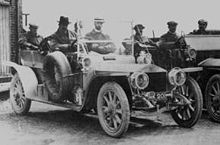| Rolls-Royce 40/50 Silver Ghost | |
|---|---|
 AX201, Roi-des-Belges tourer by Barker | |
| Overview | |
| Manufacturer | Rolls-Royce Ltd (UK) Rolls-Royce of America (US) |
| Also called | 40/50 |
| Production | 1906–1926 7874 made[1] |
| Assembly | United Kingdom: Derby, England United States: Springfield, Massachusetts[2] |
| Body and chassis | |
| Class | Luxury car |
| Related | Rolls-Royce armoured car |
| Powertrain | |
| Engine | straight 6 7036cc (429.4cid) (1906–1910) 7428cc (453.3cid) (from 1910) |
| Transmission | 3-speed manual (1909–1913) 4-speed manual (from 1913) |
| Dimensions | |
| Wheelbase | 135.5 in (3,442 mm) (1906—1913) 143.5 in (3,645 mm) (1913—1923) 144 in (3,658 mm) and 150.5 in (3,823 mm) (from 1923) |
| Chronology | |
| Predecessor | Rolls-Royce 30 hp |
| Successor | Phantom I |



7,428cc side-valve six-cylinder engine.
The Rolls-Royce Silver Ghost name refers both to a car model and one specific car from that series. Originally named the "40/50 h.p." the chassis was first made at Royce's Manchester works, with production moving to Derby in July 1908, and also, between 1921 and 1926, in Springfield, Massachusetts, USA. Chassis no. 60551, registered AX 201, was the car that was originally given the name "Silver Ghost". Other 40/50 hp cars were also given names, but the Silver Ghost title was taken up by the press, and soon all 40/50s were called by the name, a fact not officially recognised by Rolls-Royce until 1925, when the Phantom range was launched.
The Silver Ghost was the origin of Rolls-Royce's claim of making the "best car in the world" – a phrase coined not by themselves, but by the prestigious publication Autocar in 1907.[citation needed] The chassis and engine were also used as the basis of a range of Rolls-Royce Armoured Cars. In December 1923, four friends of Woodrow Wilson chipped in to buy the former president a Silver Ghost, just weeks before Wilson's death in February 1924. The car was modified so that Wilson, who was disabled, could enter and exit the car more easily.
- ^ The Rolls-Royce Motor Car. Anthony Bird and Ian Hallows. Batsford Books. 2002 ISBN 0-7134-8749-6
- ^ Cite error: The named reference
kimes1996was invoked but never defined (see the help page).